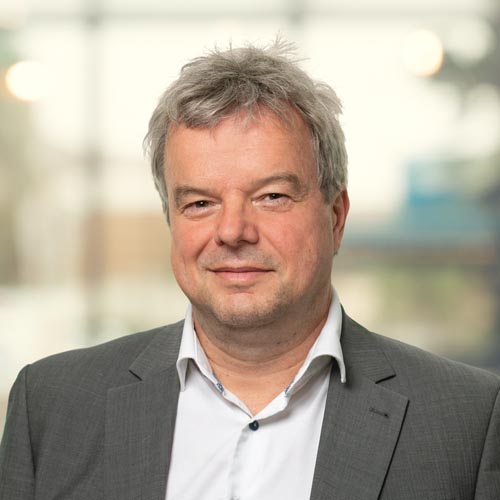
10 things you need to know about 6G
The next generation of our mobile network promises another big step forward – in capacity, reliability, and data speeds. 6G will help us digitalise further and make our society more sustainable. But what new applications does 6G offer? How can Dutch companies respond to this development? And what opportunities does 6G offer for European digital autonomy?
TNO Senior Alliance Manager Paul Wijngaard, Senior Scientist Pieter Nooren, and senior business consultant Toon Norp answer 10 pressing questions about 6G:
6G is the successor to 5G, where the ‘G’ stands for generation. 6G is thus the sixth generation of this wireless network.
Smartphones and other wireless devices need a network to send and receive data. 6G is partly an evolution of 5G, with even higher speeds and greater capacity.
In addition, 6G will be used not only for communication, but also for localisation using radar sensing. This offers the possibility of better directing traffic flows, for example. To do so, the 6G network must be able to send ‘sensing’ data in addition to communication data.
6G networks promise even higher speeds than 5G. The goal is to achieve download speeds of as much as 100Gbps: 10 times faster than the theoretical download speed of 5G, and as much as 300 times faster than the most advanced 4G networks.
But equally important is greater reliability, making autonomous driving a more realistic possibility, for example. Coverage will also be even better thanks to new radio technology and the ability to combine satellite networks with mobile networks. Finally, the 6G network will also be a lot more sustainable, through more economical use of energy and materials.
With 5G being steadily rolled out, developers have started thinking about the next generation of mobile network technology. The transition from 4G to 5G and 6G is a gradual process. About every 10 years, we work towards a major technological step and for 6G, this is expected to be around 2030.
Yes, 6G capacity has the potential to provide internet to many more wireless devices without compromising speed. And this is necessary, because with the further digitalisation of our society, our data consumption will see another sharp increase.
To make that possible, the architecture of 6G looks considerably different from that of 5G. Not only is 6G cloud-based, which 5G already is to a large extent, but the really new aspect is the application of AI to make the best use of the 6G network and have it respond in real time to disruptions or rapidly increasing demand for capacity.
6G is being developed with a strong focus on societal challenges. Sustainability was already important for 5G, but it’s even more in the spotlight with 6G.
First and foremost, by using less energy and material in the 6G networks. Indirectly, 6G also contributes to the further digitalisation and sustainability of our energy supply, industry, and mobility.
Precisely because 6G and digitalisation will play such a major role in our economy and society, it’s important that we in the Netherlands and Europe maintain control over the development and architecture of 6G.
With 5G, European companies have built a strong position in radio components for antennas and network technology. But the arrival of 6G completely reshuffles the cards, creating a race between the regions of China, Europe, and the United States.
With an eye on European digital autonomy and our Dutch earning power, it’s important to stay on the ball when developing 6G. By paying close attention to new chains that emerge, we in Europe can lay a solid foundation for our digital autonomy.
With 6G, we can not only improve existing solutions, but also open up new opportunities. Here are a few examples:
- In industry, it will be possible to improve and update complex machines as quickly as we are now used to doing with the apps on our phones.
- Traffic flows at intersections (with or without traffic lights) can be controlled much more efficiently and safely, as 6G can detect traffic participants in a privacy-compliant way.
- For invasive operations, 6G will provide optimal visual support with image-guided systems and a simpler IT environment for hospitals, making heathcare better and more affordable.
Many of these new uses will employ AI applications running in the 6G cloud. In the process, 6G will also ensure that different applications can reliably interact with each other.
The global standardisation process of 6G is currently starting up. A strong national vision and collaboration between companies, public authorities, and knowledge institutions is essential for securing our Dutch earning power for 6G.
To this end, we’ve created the Future Networks Services consortium in the Netherlands. In this consortium, more than 60 partners are working with TNO to develop components, networks, and applications for 6G.
The Future Networks Services consortium aims to build on the strong positions the Netherlands has already built with 5G. These are:
- Intelligent radio components and antennas: Dutch companies NXP and Ampleon are world market leaders in key radio components for today’s 4G and 5G mobile networks.
- Intelligent networks: the Netherlands has state-of-the-art knowledge about software, including network software, at universities, at SURF, and at young companies such as Solvinity. The networks of KPN, T-Mobile, and VodafoneZiggo always have high scores in international benchmarks for mobile network quality.
- The Netherlands continues to achieve high scores in the European DESI rankings for connectivity. We also have a high position in the DESI ranking for integration of digital technology in social and economic sectors.
In relation to these strengths, the 6G Future Network Services consortium has prepared a proposal for the third round of the National Growth Fund.
The proposed 6G Future Network Services programme also includes open calls. These grant schemes (through the Netherlands Enterprise Agency, RVO) enable companies and organisations to obtain support for new research and innovation projects in the field of 6G.
We expect these innovations to take place mainly in transport, healthcare, energy, traffic, smart industry, e-commerce, and sport.
Get inspired
TNO to investigate 5G technology in the North Sea


5G



